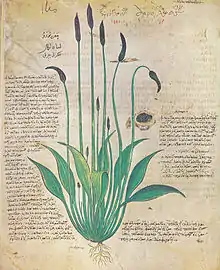Crateuas (physician)
Crateuas or Cratevas, nicknamed the Rhizotomist (Ancient Greek: Κρατεύας ὁ ῥιζοτόμος[1]) was a Greek doctor and pharmacologist who lived around 100 BC.
.jpg.webp)

Life and works
Crateuas was the personal physician of Mithridates VI (r. 120–63 BC) of the Kingdom of Pontus. He wrote a three-part herbal in which he described the medicinal properties of plants. He produced a second, popular edition with colour images, in which the plants were arranged in alphabetical order. This is the first known herbal to have included images of the plants and was the model for very many later works of the same sort. To date, only two papyrus fragments of this work are known.[3] Pliny the Elder's Natural History records that Crateuas painted images of the plants and listed their effects below the images.[4][5]
Crateuas' book was one of the main sources for Pedanius Dioscorides. In some of the tables of the early 6th-century illuminated manuscript produced for Anicia Juliana in Constantinople, the Vienna Dioscurides, the images are captioned by short texts beginning with the name of Crateuas. An image taken from Crateuas is found in Table 3 of the Vienna Dioscurides.[6]
In the 16th century, an illustrated manuscript of Crateuas is said to have still existed in Constantinople. Luigi Anguillara claimed to have used this manuscript in drawing up his 1561 work, Semplici.[7][8] However, Max Wellmann (1897) was able to prove that a Latin version of Dioscurides's De materia medica was the source of Anguillara's work. Wellmenn also suggested that a large number of the plant images in the Vienna Dioscurides were copied from manuscripts of Crateuas dating to the 2nd or 3rd centuries AD. Charles Singer's studies supported this suggestion.[9]
Honorific Taxon
Carl Linnaeus named the genus Crateva of the plant family Capparaceae (capers) in honour of Crateuas[10][11]
References
- Evidence of spelling in „De materia medica, Dioscurides Pedianus, De materia medica, Wellmann, Weidmann, 1958“
- Der Wiener Dioskurides: Codex medicus Graecus 1 der Österreichischen Nationalbibliothek. Graz: Akademische Druck- und Verlagsanstalt 1998 (Glanzlichter der Buchkunst) ISBN 3-201-01699-3 p. 18, Kommentar von Otto Mazal
- Die Botanik in der Antike.
- Naturalis historia, 25, 8.
- Arzneimittellehre des Dioskurides.
- Maria Przybylo: Dioskurides: De materia medica.
- Luigi Anguillara. Semplici, liquali in piu pareri a diversi nobili nomini scritti appajano. Venedig 1561 MDZ München
- Kurt Sprengel. Geschichte der Medizin im Alterthume. Part I. 4th ed. Leipzig 1846, p. 593 Digitised by the Bayerische Staatsbibliothek
- Charles Singer. "The Herbal in the Antiquity." The Journal of Hellenic Studies. 47 (1927) pp. 1–52.
- Carl von Linné: Critica Botanica. Leiden 1737, p. 92
- Carl von Linné: Genera Plantarum. Leiden 1742, p. 231.
Bibliography
- Wilfrid Blunt: The Art of Botanical Illustration: An Illustrated History. Dover Publications. 1994, S. 9–12. ISBN 0-486-27265-6
- Kurt Sprengel: Kurt Sprengels Geschichte der Botanik. Altenburg und Leipzig, 1817, p. 104 MDZ München
- Max Wellmann.
- "Krateuas." In: Abhandlungen der königlichen Gesellschaft der Wissenschaften zu Göttingen. Philologisch-historische Klasse. New Series, Vol. 2, No. 1. Weidmann, Berlin 1897. Internet Archive
- "Das älteste Kräuterbuch der Griechen." In: Festgabe für Franz Susemihl. Teubner, Leipzig 1898, pp. 1–31 Internet Archive
- Zohara Yaniv: Handbook of Medicinal Plants. Haworth Press: 2005, p. 167. ISBN 1-56022-995-0